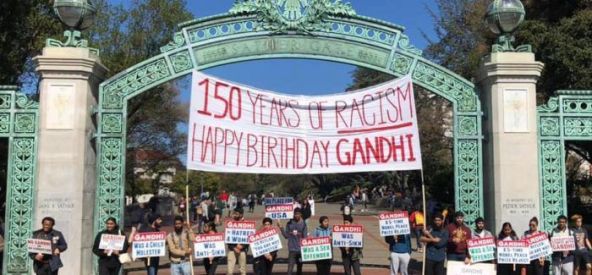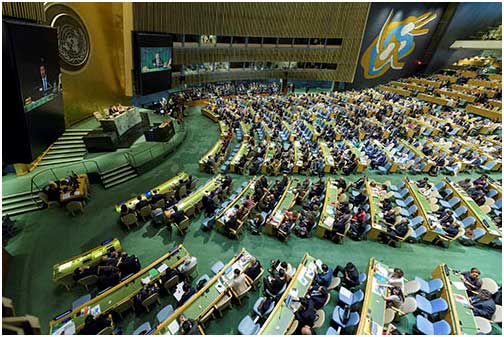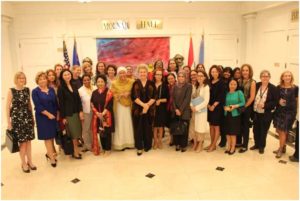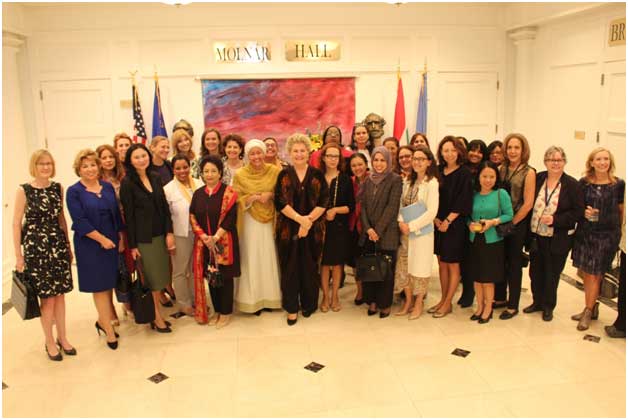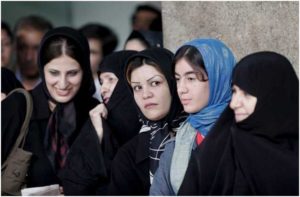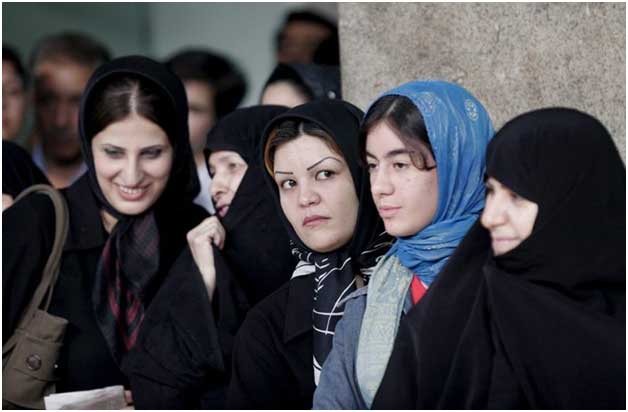
Armed Conflicts, Civil Society, Featured, Global, Global Geopolitics, Headlines, TerraViva United Nations
Izumi Nakamitsu is UN High Representative for Disarmament Affairs*
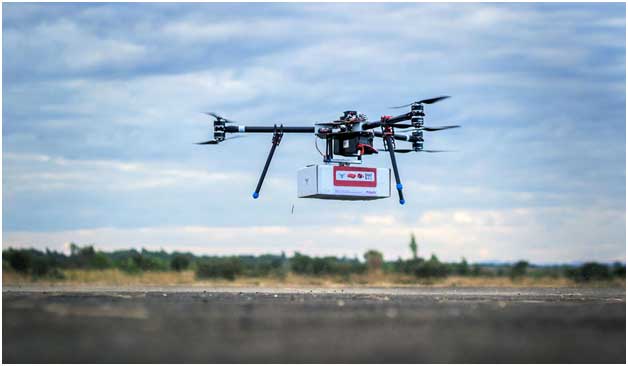
Credit: UN peacekeeping
– Throughout history, technology has transformed armed conflict. The carnage of First World War battlefields is a stark example of what happens when advances in weaponry outpace the normative frameworks around its use.
Today, we are experiencing a technological revolution that holds incredible promise for human development and welfare. From genome editing to quantum computing and artificial intelligence, emerging technologies offer us powerful new ways to achieve our shared commitments, including the Sustainable Development Goals.
Our networked society is promoting a “democratization” of technological dissemination. Ease of understanding and using technology is greater than ever before. Yet these benefits also bring with them clear risks for international peace and security.
Before I address the trends and consequences of the current technological context, I want to add my usual caveat: it is important not to be alarmist about the ramifications of technology, but at the same time not dismissive either.
With that, let me share with you some of the major trends in conflict risk as I see them and the implications they carry for international peace and security.
First, the application of technology to new means and methods of warfare is aggravating an arms-racing dynamic in both conventional and nuclear weapons. This dynamic is evident in the eye-watering amounts of money spent on weapons – some 1.8 trillion dollars last year, according to SIPRI – and the nuclear modernization campaigns that are, in effect, a qualitative nuclear arms race.
This is both exacerbated by, and in turn exacerbates, the absence of transparency and confidence in international relations. As States strive to develop newer and better weapons, it threatens to undermine stability and increase the prospects for unintended and potentially uncontrollable escalation.
This dynamic is not limited to States with advanced technological bases. The democratic characteristics of technological innovation provide for creative asymmetric responses – the digital IEDs, if you will.
The second trend I want to highlight is how technology is opening new potential domains for the conduct of hostilities.
Military operations using emerging technologies and in new domains can involve actions that are not easily classifiable or fall below traditional thresholds for an armed attack or an act of aggression.
This creates challenges for international peace and stability, as even non- permanent means of disrupting or disabling a military capability can prompt a conventional armed response.
Take, for example, what is commonly referred to as “cyber warfare”.
The frequency of malicious cyber incidents is growing, along with their severity. Such acts are contributing to diminishing trust and confidence among States and encouraging them to adopt offensive postures for the hostile use of these technologies.
The difficulty of attributing responsibility for cyber-attacks could result in unwarranted armed responses and escalation. Constraints agr the case of cyberattacks that do not cause physical damage and are not lethal.
New domains and methods of warfare will also change the impact on civilians in ways that are less kinetic but equally damaging. For example, “casualties” in a cyber conflict could include millions of people who have had their bank accounts wiped out by an offensive cyberattack.
Put differently, some of these new technologies could not only change the size and speed of destruction in conflict, but also the character and nature of destruction in war.
A third and related trend is how certain new technologies, in particular armed uncrewed aerial vehicles, are undermining civilian protections. Lower risks to armed forces and comparatively lower levels of physical violence risk lowering the threshold on the use of armed force in situations where it would not otherwise have been contemplated.
Such actions not only endanger civilians, but risk escalating conflict.
The fourth and final trend I want to draw attention to is the emerging nature of warfare enabled by networked militaries, autonomy, uncrewed vehicles, advanced sensors, and weapons that can attack at hypersonic speeds.
This form of warfare is not yet fully realized, but technological innovation, coupled with evolving military thinking, is trending the world in this direction with several significant risks.
So-called “hypersonic weapons” pose particular concerns because they could both reduce decision-making times while also adding ambiguities related to the nature of their targets and their own payloads, whether conventional or nuclear.
Increased adoption of Artificial Intelligence (AI) may lead to decision-making processes faster than human cognition and concern has been expressed about the potential for unpredictable and non-transparent behaviour by AI in armed conflict.
Increasing autonomy in the critical functions of weapons systems raises serious ethical and legal questions for existing frameworks and how to ensure human accountability for the use of force. The growing use of UAVs and increased autonomy could lead to perceptions of casualty-free warfare.
The possibility of third parties with malicious intent interfering in control systems to incite conflict cannot be discounted.
The potential for such advances to exacerbate political divisions and global tensions would be alarming even in the most benign of international environments.
However, we are currently mired in a geostrategic context defined by distrust, the militarization of international relations and a dearth of dialogue. Relations between the so- called “great powers” are eroding as the rules-based international order – including the disarmament and non-proliferation regime – is being challenged.
Other global issues – climate change, mass migration and social unrest – will also continue to affect the nature and conduct of armed conflict.
In this unsettling environment, where brakes on warfare are being removed, the utmost caution should be exercised in the deployment of technological innovations with disruptive ramifications.
Having said this, it is easy to list risks and challenges. It is a much harder task to elaborate solutions.
I would like to suggest today what might be some of the key elements, from the United Nations’ perspective, for our joint work ahead to elaborate possible solutions. Some of them relate to substance, others to the process and partnerships we must forge.
First, a few points related to the development of norms and their operationalization or implementation.
One of the most prominent debates in the governance of emerging technologies has been whether international frameworks can adequately contain new risks and concerns. There is divergence over whether existing law is sufficient or whether new legal instruments are required.
Some new technologies, such as armed drones, have prompted concerns about how they can tempt some to reinterpret international law.
What we need is an honest debate about how international law applies to any possible use of emerging technologies as weapons, how any such uses are constrained or prohibited by existing international law and where new approaches, including new law, is needed to mitigate foreseeable risks.
Increased transparency and accountability in the use of new technologies could help increase confidence in adherence to international law. When it comes to the weaponization of new technologies, broadened use and transparency of weapons reviews – those required under article 36 of Additional Protocol I to the 1949 Geneva Conventions – would build confidence about the legality of those weapons systems.
Regardless of where States sit on this debate, protecting civilians from the effects of armed conflict must continue to be a central concern when addressing the means and methods of warfare.
This is a tenet that we cannot lose sight of as States rush to utilize technological innovations in armed conflict.
We must reinforce mechanisms for the protection of civilians, including respect for and compliance at all times with applicable international law, including international humanitarian law.
While Member States will continue to have primary responsibility in matters of international peace and security, twenty-first century norm-making cannot be just straightforward treaty negotiations between States.
Much of the technology we have been discussing today is either dual-use or even enabling. Its creators need to be brought into the fold.
The importance of developing effective multi-stakeholder platforms that can bring together experts from Member States, industry, academia and civil society should be a priority.
This is important not only to ensure that intergovernmental deliberations are adequately informed, but also that technical communities are aware of the context and possible consequences of their work.
Modern norm-making should consider a broad spectrum of responses, from self-regulation such as code of conducts, to political initiatives such as transparency and confidence-building measures, to comprehensive and multifaceted efforts in the traditional intergovernmental negotiations.
Secondly, while each of these technologies will have a disruptive individual impact, it is at their convergence where the real challenges lie.
We need to generate a better understanding of the combined effects, especially of enabling technologies such as cyber and AI that will impact everything, not least each other. What, for example, will be the impact of autonomous malware?
I am particularly worried about how the combined use of technological innovations could upend strategic stability and lower the barriers to the use of a nuclear weapon.
Concepts such as “left of launch” missile defence – the disabling of nuclear command and control structures by cyber means – could create “use it or lose it” mentalities for first strikes.
Experts have raised the possibility of AI deep fakes to spoof command and control or early warning systems, as well the prospect of so-called “data poisoning”, the deliberate alteration of the data on which AI runs to produce unintended outcomes.
Because of such risks, Cold War concepts, including classical deterrence models, should be re-evaluated for the digital age where terms such as “cyber deterrence” could have dangerous escalatory consequences. In this era, instead of deterring conflict we need to better focus on preventing it.
In the UN context, we have made good progress to address some of the challenges posed by innovations in technology.
On autonomous weapons, States considering this issue within the Convention on Certain Conventional Weapons have produced three consensus reports. My office stands ready to support Member States to build on the commonalities identified in those reports, including by elaborating measures to ensure that humans remain in control of the use of force.
Five UN Group of Governmental Experts have agreed that international law applies to the use of ICTs and that the UN Charter applies in its entirety. In 2015, the GGE was able to forge 11 voluntary non-binding norms to reduce risks to international peace, security and stability. That work continues now in two forums – an Open-Ended Working Group that met earlier this month, and another GGE that will convene later this year.
To help facilitate responses to their potential risks, my office, together with the United Nations Institute for Disarmament Research, published a study on hypersonic weapons. The study makes the case for multilateral discussion of these weapons, the development of which cannot be seen in isolation from the current deterioration in strategic arms control. We have now convened two track 1.5 meetings to inform and explore its findings.
Member States have taken practical steps to preserve peace and security by developing and commencing the implementation of transparency and confidence-building measures in outer space activities.
Later this year, the First and Fourth Committees of the General Assembly will convene a third ad hoc meeting on possible challenges to space security and sustainability.
A GGE on the prevention of an arms race in outer space also met earlier this year. Unfortunately, it was unable to agree on a substantive report, but nevertheless had the most substantive dialogue since the item was introduced to the Conference on Disarmament in 1985.
As you can see, there have been good discussions taking place in various individual areas of new technology. It is important to start now in understanding what might be the possible combined impact of these technologies in today’s international security environment. This leads me to my third and final key issue.
The disruptive nature of technological innovations and the convergence between them has prompted calls for new thinking in disarmament, arms control and non-proliferation.
As the Secretary-General said in February this year: “We need a new vision for arms control in the complex international security environment of today.”
Any new vision would need to preserve the indispensable benefits of the existing frameworks but could address many of the issues I have already mentioned. It should encompass all kinds of nuclear weapons and their qualitative developments.
It could consider particularly destabilizing categories of weapons such as hypersonic weapons. It could take into account new developments in technology and the potential vulnerabilities these have exposed, as well as the convergences between them, and new models of governance.
It should preserve and further develop or strengthen measures for protection of civilians in any type of conflict. And it should enable the use of these technologies for our collective benefit, in conflict prevention and peace-building mechanisms, and also arms control, disarmament and non-proliferation.
The UN has the convening power to create different types of platforms and discussion mechanisms. It is uniquely situated to be an impartial convener and bring in non-government actors so that multiple stakeholders can learn from each other and develop creative, mutually beneficial solutions.
I believe that the UN system, due to its broad expertise, is also well-placed to act as a catalyst for innovative thinking. I believe the UN has to play a central role in bringing together the security and humanitarian discourses in a new vision for arms control and disarmament.
And I believe the UN should contribute creative ideas to maximize the benefits and minimize the challenges of disruptive technology.
The use of technology in warfare in ways that undermines our collective security is not a forgone conclusion. Through dialogue, transparency, negotiation and cooperation, we can build the normative framework that prevents the direst of scenarios from taking place. I look forward to working together to secure our common future.
*In an address to the fourth annual Stockholm Security Conference at the Stockholm International Peace Research Institute (SIPRI)


